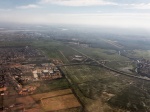
Porto Alegre, the capital of Rio Grande do Sul State, is one of the main economic and cultural centers south of São Paulo for medical tourism. Located by the Guaiba River, Porto Alegre is renowned for its incredible sunsets. The culture and traditions of the southern state of Brazil is very similar to its neighbor Argentina-both cultivate the"pampas" traditions- cowboy lifestyle.
Although Porto Alegre is proud of its origins, it’s also a modern and lively city, with an active cultural life, thriving commerce and industry, agitated nightlife and many museums, excellent restaurants, bars, modern shopping malls and health tourism communities.
Activities in Porto Alegre
Advisory
Please be advised that you may not be able to participate in certain activities after receiving your medical travel treatment. Your doctor will be able to advise you on the appropriate activities in which you can participate.
Walking
Porto Alegre’s downtown area, with its preserved historical treasures - old buildings that have been reformed and turned into cultural centers and art and historical museums - offers great tours. The main points of reference are the Praça Senador Florêncio (the Senator Florêncio Square - known also as Praça da Alfândega, the Custom’s Square), 15-de Novembro Square (or the Praça da Matriz, the Main Church’s Square) and Rua dos Andradas (Andradas’ Street), also known as “Rua da Praia” (the Beach Street).
Shopping
The old city Public Market in Praça 15 de Novembro originally built in 1869, was reformed and modernized in 1997, but it still keeps its function of supplying the city with all kinds of food, such as meat and fish. There you may find typical “gaucho” products, such as mate herbs, bowls for drinking “chimarrão” and ponchos. It also contains several restaurants and snack bars.
Museums
The Museum of Art of Rio Grande do Sul (MARGS) contains approximately three thousand works by national and foreign artists, from as early as the 19th century, with emphasis on local, “gaucho” artists. In the museum you may see works by well-known Brazilian artists such as Di Cavalcanti, Portinarti, Lasar Segall, Guignard, Iberê Camargo and Marcelo Grassman. The building, of eclectic architectural style, was built in 1913 to shelter the city’s Fiscal/Internal Revenues Offices.
The Piratini Palace (State Government Headquarters) occupies this French neoclassic-style building, built around the beginning of the 20th century’s. It exhibits rich decoration art, including also panels and murals painted by Italian artist Aldo Locatelli, which portrait traditional “gaucho” scenes and history. Old official government automobiles are also exhibited.
The Júlio de Castilhos Museum maintains a collection, which comprises approximately 10 thousand pieces with the purpose of showing the history and culture of Rio Grande do Sul. The diversified collection includes documents, furniture, machines, armory and domestic goods. The house that shelters the museum is an example of a typical “gaucho” rich family residence around 19th century’s end.
Theater & Cinema
São Pedro Theater has an extensive display of artistic and cultural activities, and has staged a great number of theater plays, dance and musical performances. Opened in 1858, the theater was reformed and modernized in 1984. The neoclassic-style building offers a rich decoration, with special highlight to the 600-kilo, 35-thousand crystal pieces chandelier. It hosts also a restaurant and a bar.
The Mário Quintana House of Culture offers rooms with exhibitions, cinema, theater and café. It is installed in the old Hotel Majestic building, from 1933, which served for many years as residence for one of the most important Brazilian poets, “gaucho” Mário Quintana.
Parks
The city has a great number of parks and public squares and offers one of the highest rates of green areas per inhabitant in the country. Porto Alegre’s parks offer good infrastructure and are usually used as leisure time areas by the local population. Some of the city’s main parks are:
Parque Farroupilha (The Farroupilha Park), contains a mini-zoo, an amusement park for children, sports fields, athletic sports tracks, gymnastic equipment and a huge auditorium. On Monday mornings the Farroupilha Park hosts a traditional antiques, handcraft and arts fair. Theater and music groups can usually be seen performing around the park. It is one of the city’s most popular events.
Jardim Botânico (The Botanical Garden) has 725 species of vegetation and can be seen between more than 2 thousand plants and trees spread along around 43 hectares of land. The Museu de Ciências Naturais (Natural Sciences Museum) helps conserve typical specimen from the local fauna and flora.
Food
Barbeque is the main item of “gaucho” cuisine. Meat on sticks or on grills, seasoned with unrefined salt, is roasted from the heat of burning charcoal. Many cuttings of meat are used to prepare a barbeque, but more traditional “gauchos” appreciate ox rib as the most authentic piece. Other very appreciated options are sirloin, tenderloin, some parts of mutton, including also sausages and chicken heart that are usually served as appetizers. “Mandioca” flower (a root plant very popular in Brazil) is an indispensable side dish, and salads are also served. In barbeque restaurants that offer the “rodízio” (rotational) system (or “espeto corrido” [“running sticks”], as the gauchos call it), it is possible to try many types of meat and hot and cold dishes at a fixed price. The habit of eating barbeque has spread throughout Brazil. But it’s seen as a true ritual for the population of Porto Alegre, as well as for every “gaucho” in Rio Grande do Sul. It is widely prepared in family house parties or consumed in barbeque restaurants.
Accommodations